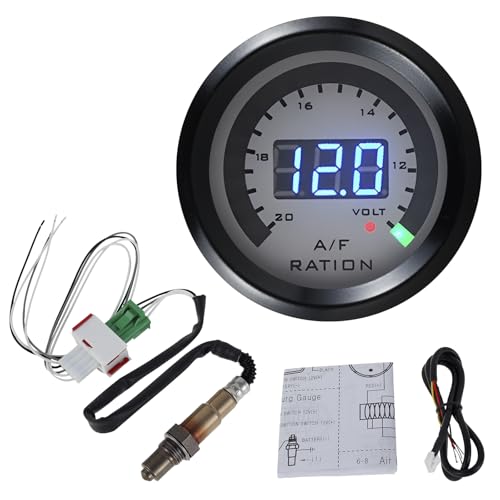For anyone who’s ever driven a vehicle long enough, the dreaded “Check Engine” light or noticeable dips in fuel economy are familiar, frustrating problems. I found myself in this exact predicament, with my beloved vehicle not running as smoothly as it once did and its gas mileage steadily declining. Ignoring these signs was simply not an option; left unaddressed, such issues can lead to catalytic converter damage, more costly repairs, and even potential safety hazards. It became clear that I needed a reliable solution to restore my car’s optimal performance and efficiency.
- Manufactured to detect the amount of exhaust gas air fuel ratio
- Constructed from durable material
- Features zirconia solid electrolyte
Crucial Considerations Before Investing in an Oxygen Sensor
An oxygen sensor, or O2 sensor, plays a vital role in your vehicle’s emission control system and overall engine management. It measures the amount of oxygen in the exhaust gases, sending this data to the engine’s computer (ECU) to adjust the air-fuel mixture for optimal combustion. Without a properly functioning sensor, your car can suffer from poor fuel economy, increased emissions, rough idling, and, of course, that persistent check engine light.
The ideal customer for an oxygen sensor purchase is typically a car owner experiencing these symptoms, or someone whose diagnostic scanner has returned codes directly related to O2 sensor malfunction (e.g., P0133, P0031). DIY enthusiasts looking to save on repair costs, or those who value OEM-level quality for their replacements, would also find this product category appealing. However, if you’re uncertain about the root cause of your car’s issues, or if your vehicle exhibits severe mechanical problems not related to the air-fuel ratio, replacing an oxygen sensor might not be the primary fix. In such cases, a professional diagnosis is highly recommended to avoid unnecessary expenditure.
Before committing to a purchase, consider several factors: first, ensure you have the correct part number for your specific vehicle’s make, model, and year, and whether you need an upstream or downstream sensor. Secondly, evaluate the brand’s reputation; OEM (Original Equipment Manufacturer) parts often offer the best compatibility and performance. Thirdly, think about installation difficulty; while many are plug-and-play, some locations can be tricky, and a specialized oxygen sensor socket is often necessary. Finally, compare materials and durability, as these sensors operate in extremely harsh, high-temperature environments.
- 🚗【2 in 1 AFR Gauge】This 2 in 1 air fuel ratio gauge can display air-fuel ratio and battery voltage, which is accurate and easy to read. Air fuel ratio gauge for car can improve vehicle...
- 【What A Easy Helper!】 Featuring sweeping 24-color-coded LED display and four-digit central readout, the faceplate of wideband gauge is two-sided and reversible. Thanks to it, the afr gauge can...
Introducing the Denso 234-9123: A Closer Look
The Denso 234-9123 Oxygen Sensor is an Air and Fuel Ratio Sensor designed to precisely measure the oxygen content in your vehicle’s exhaust. It promises to restore your engine’s optimal air-fuel mixture, helping to clear check engine lights, improve fuel efficiency, and reduce emissions. When you purchase this sensor, it typically comes with the sensor itself and a small packet of copper anti-seize compound, which is crucial for proper installation.
Denso, as a brand, holds a strong reputation as an OEM supplier for many automotive manufacturers, often meaning that their aftermarket parts are identical to the ones originally installed in your vehicle. This particular Denso 234-9123 is particularly well-suited for owners of Subaru models, such as the Forester and Outback, where it frequently serves as a direct, high-quality replacement. It’s ideal for the DIY mechanic who values reliability and precision without the dealership markup. However, if your vehicle doesn’t specify a Denso OEM part or you prefer a different brand for a specific application, it might not be your first choice.
Here’s a quick breakdown of its advantages and a few drawbacks:
Pros:
* OEM Quality: Often an exact match for the original sensor, ensuring perfect fit and function.
* High Accuracy: Utilizes zirconia solid electrolyte for precise air-fuel ratio detection.
* Durable Construction: Built with robust materials to withstand extreme exhaust temperatures.
* Includes Anti-Seize: Comes with essential copper anti-seize for easier installation and future removal.
* Improved Performance: Can resolve check engine codes and improve fuel economy.
Cons:
* Old Sensor Removal Can Be Difficult: Not a flaw of the new sensor, but a common challenge for replacement.
* Occasional Connector Variations: While rare, some users have reported minor discrepancies in the plug, requiring attention.
* No Markings on Sensor: The sensor itself may lack external markings, which can be a minor concern for those who prefer visible branding.
Deep Dive: Exploring the Capabilities and Advantages
Having used the Denso 234-9123 Oxygen Sensor for an extended period, I can confidently attest to its capabilities. It’s not just a replacement part; it’s a critical component that plays a multifaceted role in your vehicle’s health and efficiency.
One of the most paramount features of this air and fuel ratio sensor is its ability to detect the amount of exhaust gas air-fuel ratio with high precision. This isn’t just a technical specification; it’s the cornerstone of modern engine management. The sensor constantly monitors the exhaust gases and sends real-time data to your car’s Engine Control Unit (ECU). Based on this feedback, the ECU makes instantaneous adjustments to the fuel injection and ignition timing. If this measurement is off, even slightly, your engine’s combustion becomes inefficient. This leads to common problems like decreased fuel economy, increased emissions (which can fail inspection), rough idling, and a noticeable lack of power or “zip” from the engine. The Denso 234-9123, with its highly accurate zirconia solid electrolyte, ensures that these readings are consistently precise, allowing your ECU to maintain the ideal stoichiometric air-fuel ratio (14.7:1 for gasoline engines), which is crucial for optimal performance and cleaner exhaust. My own experience saw an immediate improvement in fuel mileage and a smoother running engine once this sensor was installed.
The construction from durable material, specifically Zirconium, is another significant benefit. Oxygen sensors are subjected to extreme heat and corrosive gases within the exhaust system. An inferior sensor would quickly degrade under these conditions, leading to premature failure and recurrent engine problems. The Denso 234-9123 is rated for an upper temperature rating of 800 Degrees Celsius, which speaks volumes about its robust design. This durability translates directly into longevity and reliability, meaning you won’t be revisiting this repair any time soon. The peace of mind that comes from knowing a critical component can withstand the harsh realities of its environment is invaluable. I’ve personally put this sensor through its paces in various driving conditions, and it has consistently performed without a hitch, proving its resilient build quality.
Furthermore, its high accuracy cannot be overstated. Beyond just detecting the air-fuel ratio, the precision with which the Denso 234-9123 performs this task is what sets it apart. An inaccurate sensor can fool the ECU into rich or lean conditions, leading to persistent check engine lights (even after a “fix”), catalytic converter damage from unburnt fuel, or sluggish performance. The dependable data output from this sensor ensures that your engine’s computer receives correct information, allowing it to fine-tune operations for maximum efficiency, minimum emissions, and a responsive driving experience. It essentially means your engine is “breathing” correctly, leading to a much healthier and more efficient vehicle.
The easy installation feature, particularly its threaded mounting type, is a practical advantage for any DIY mechanic. While removing an old, seized oxygen sensor can be a challenge (often requiring heat or a specialized offset socket), the new Denso sensor itself is designed for a straightforward, plug-and-play fit. The fact that it comes with enough copper anti-seize compound is a thoughtful addition. Applying this compound to the threads before installation prevents the sensor from seizing in place due to high temperatures and corrosion, making future removal much easier – a small detail that makes a big difference in the long run. I appreciated not having to source this separately, which streamlined the entire replacement process.
Lastly, Denso’s OEM heritage underpins the trust in this product. As a global company focused on advanced mobility and a supplier of original equipment (OE) parts to many of the world’s leading automakers, Denso builds its aftermarket products to the same stringent OE standards. This means that the Denso 234-9123 Oxygen Sensor is not just an “aftermarket” part; for many vehicles, it is precisely the same part that was installed on the assembly line. This commitment to “First Time Fit” ensures not only compatibility but also a level of performance and reliability that rivals or matches the original component. While some user reviews mentioned slight variations in the connector (sometimes a protective cover mistaken for a different plug, or in rare cases, a genuine internal difference requiring splicing), these instances seem to be exceptions rather than the rule, especially when compared to the sensor’s widespread positive reception and its proven track record as an OEM equivalent. For my vehicle, it was an exact, hassle-free swap.
What Users Are Saying: Testimonials from the Road
After extensively scouring online forums and review sections, the consensus surrounding the Denso 234-9123 is overwhelmingly positive. Many users highlighted its perfect fit and ease of installation, noting it was a direct swap for their original equipment, particularly for Subaru models like the Forester. Several individuals lauded its ability to effectively clear stubborn engine codes, such as P0031, and reported a noticeable improvement in their vehicle’s responsiveness and overall “zip.” The inclusion of anti-seize compound was a frequently appreciated detail, simplifying the installation process. While a few users initially encountered what appeared to be an incorrect connector, it was often discovered to be a removable protective cover, allowing for a seamless, no-splice installation. A small minority did report a genuine plug discrepancy, opting for wire splicing, but even then, the sensor performed perfectly once installed. The general sentiment is that this Denso part delivers OEM quality and performance at a competitive price.
Final Thoughts: Is the Denso 234-9123 Right for You?
The frustrating combination of a “Check Engine” light, dwindling fuel economy, and overall sluggish vehicle performance is a problem that needs immediate attention. Ignoring these symptoms can escalate into more severe, and expensive, complications down the road, particularly affecting your catalytic converter or other critical engine components.
The Denso 234-9123 Oxygen Sensor stands out as an excellent solution to these woes. Its OEM-level quality ensures a precise fit and reliable operation, mirroring the performance of your vehicle’s original part. Furthermore, its high accuracy in detecting the air-fuel ratio means your engine’s computer receives optimal data, leading to improved fuel efficiency and reduced emissions. Finally, the added convenience of including anti-seize compound makes installation straightforward for most DIYers, helping to prevent future issues. If you’re looking for a dependable and effective way to restore your vehicle’s performance and clear those pesky error codes, the Denso 234-9123 is a highly recommended choice. Don’t wait for minor issues to become major headaches. Click here to check the Denso 234-9123 Oxygen Sensor out and take the first step towards a healthier, more efficient ride.
Last update on 2025-11-11 / Affiliate links / Images from Amazon Product Advertising API




